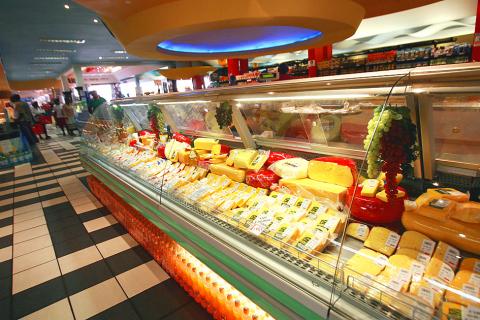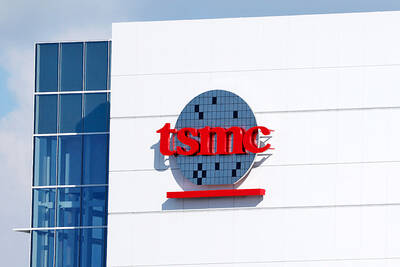Zimbabwean restaurant-goers used to pull out giant wads of near-worthless cash that could take longer to count than the time to eat the meal. If the order was even available.
Now diners can peruse anything from wild pigeon consomme to Brazilian churrascaria meats, paid for with a few dollar bills. And once-empty supermarkets boast exotica like biscotti and crusty baguette sticks as “dollarization” — with the US dollar the de facto currency after the government ditched the local money battered by hyperinflation — revives the capital’s food scene.
“Everything was a major problem. You went to a speciality restaurant which didn’t have the speciality,” recalled restaurant critic Dusty Miller at the Standard, an independent weekly newspaper.

PHOTO: AFP
“It really was almost ... you paid for your soup when you got it because if you waited till after your pudding the bill had gone up 20 percent,” he said.
Now under a 2008 political power-sharing pact and the introduction of the US currency last year, Harare’s food scene has done a U-turn. Choices range from US$1 spots selling sadza, a traditional maize porridge with a dollop of stew, to a chocolate shop offering 75 flavors.
“Over the past year there’s been a lot happening,” said Joseph Bunga, director of a year-old online restaurant guide catering mainly to middle-class and corporate clients. Zimbabwe’s economic meltdown led to widespread shortages, from fuel to empty supermarket shelves, after years of political turmoil under veteran leader President Robert Mugabe. Yet even during the crisis years, some restaurants were artificially busy.
“If I spent my 100,000 [Zimbabwean] dollars tonight, I could eat a beautiful steak, but tomorrow I couldn’t buy a potato with that money,” Bunga said.
“So what would I do? I’d go and I’d spend the money that same evening,” said Bunga, who once paid for a meal with a wad of cash the size of a rugby ball.
Bunga, who started his “Eat Out Zimbabwe” site with the upswing, estimates that 20 new eateries have opened in the country in the last year.
His guide now lists 238 restaurants, carries reviews for local and visiting “foodies” and recently launched a restaurant booking service.
“There’s more competition out so everyone is fighting for that small percentage of the market that can afford to go out to restaurants,” said Julie Webb, who owns the sleek Mojo’s Brazilian-style barbecue restaurant with partner Mohamed Samy.
Supermarkets, whose empty shelves forced many shoppers to cross borders to buy the basics, are now packed not only with staples but also luxury foods like cakes, mushrooms, Japanese soba noodles and French cheeses.
“It’s improved drastically,” said Marios Pavlou, operations director of the Athienitis Spar grocery, one of several outlets of the global food retailer in the capital.
“Every day was an uphill struggle for us. Most of our days were spent just trying to keep afloat and adjust prices to keep in line with our suppliers,” Pavlou said.
“There are a lot of stores that have opened in past few months and probably before December, another 10 Spar stores are going to open,” Pavlou said. “So that’s a sign that obviously the grocery industry is growing fast.”
Like many shoppers, Mary Mbewe is glad the days are gone when half a liter of long-life milk could cost 60 billion Zimbabwean dollars and a kilogram of beef 438 billion Zimbabwean dollars, according to July 2008 state-set prices.
“I can buy whatever I want as long as I have the money,” she said.
Though the economy has shown a second straight year of growth, there are still challenges. For one, the bulk of goods today are imported as local suppliers struggle to re-emerge — in a country whose commercial farming was once a source of exports and foreign exchange.
Moreover, although the situation has improved since the peak of the food crisis in 2008, when about half the nation’s 12 million people needed aid with the failure of crops and the collapse of the economy, about 1.7 million Zimbabweans still need food aid today, according to UN food agencies estimates in August.
Still, most Zimbabweans “could not dream of coming to a lovely restaurant like this,” Miller said during Mojo’s lunch trade.
Unemployment and poverty remain high, and even civil servant salaries average only about US$200, like many Zimbabweans.
“They’re lucky to get a square meal on the table perhaps every other day. That is a tragedy,” Miller said.

Real estate agent and property developer JSL Construction & Development Co (愛山林) led the average compensation rankings among companies listed on the Taiwan Stock Exchange (TWSE) last year, while contract chipmaker Taiwan Semiconductor Manufacturing Co (TSMC, 台積電) finished 14th. JSL Construction paid its employees total average compensation of NT$4.78 million (US$159,701), down 13.5 percent from a year earlier, but still ahead of the most profitable listed tech giants, including TSMC, TWSE data showed. Last year, the average compensation (which includes salary, overtime, bonuses and allowances) paid by TSMC rose 21.6 percent to reach about NT$3.33 million, lifting its ranking by 10 notches

Popular vape brands such as Geek Bar might get more expensive in the US — if you can find them at all. Shipments of vapes from China to the US ground to a near halt last month from a year ago, official data showed, hit by US President Donald Trump’s tariffs and a crackdown on unauthorized e-cigarettes in the world’s biggest market for smoking alternatives. That includes Geek Bar, a brand of flavored vapes that is not authorized to sell in the US, but which had been widely available due to porous import controls. One retailer, who asked not to be named, because

SEASONAL WEAKNESS: The combined revenue of the top 10 foundries fell 5.4%, but rush orders and China’s subsidies partially offset slowing demand Taiwan Semiconductor Manufacturing Co (TSMC, 台積電) further solidified its dominance in the global wafer foundry business in the first quarter of this year, remaining far ahead of its closest rival, Samsung Electronics Co, TrendForce Corp (集邦科技) said yesterday. TSMC posted US$25.52 billion in sales in the January-to-March period, down 5 percent from the previous quarter, but its market share rose from 67.1 percent the previous quarter to 67.6 percent, TrendForce said in a report. While smartphone-related wafer shipments declined in the first quarter due to seasonal factors, solid demand for artificial intelligence (AI) and high-performance computing (HPC) devices and urgent TV-related orders

MINERAL DIPLOMACY: The Chinese commerce ministry said it approved applications for the export of rare earths in a move that could help ease US-China trade tensions Chinese Vice Premier He Lifeng (何立峰) is today to meet a US delegation for talks in the UK, Beijing announced on Saturday amid a fragile truce in the trade dispute between the two powers. He is to visit the UK from yesterday to Friday at the invitation of the British government, the Chinese Ministry of Foreign Affairs said in a statement. He and US representatives are to cochair the first meeting of the US-China economic and trade consultation mechanism, it said. US President Donald Trump on Friday announced that a new round of trade talks with China would start in London beginning today,